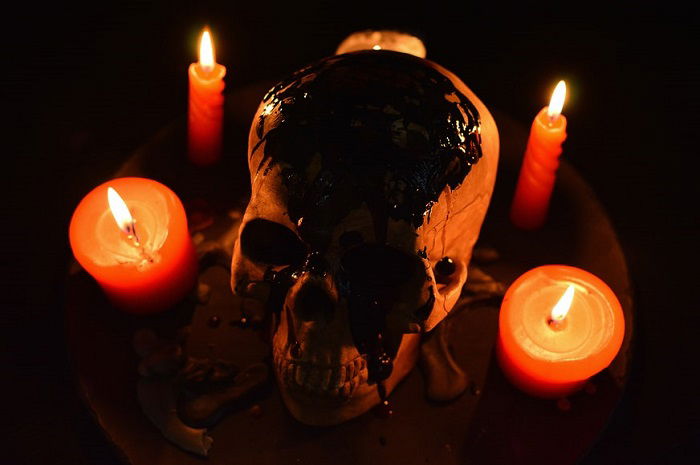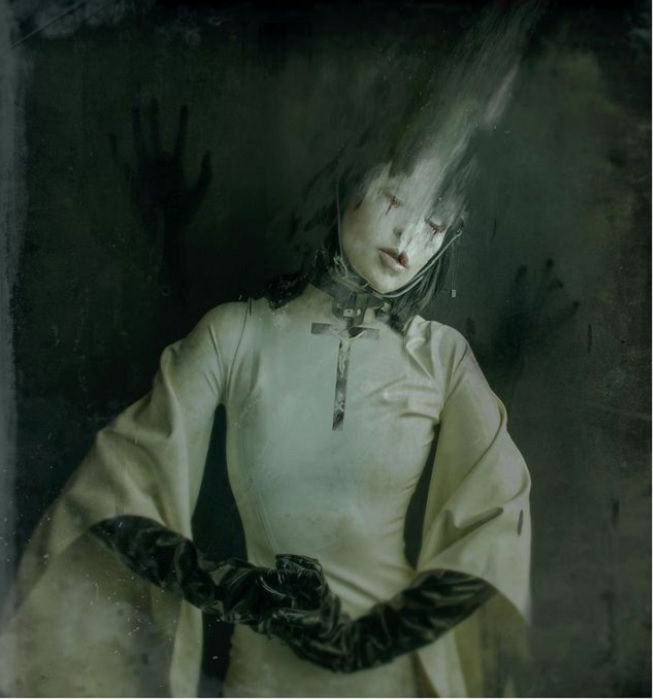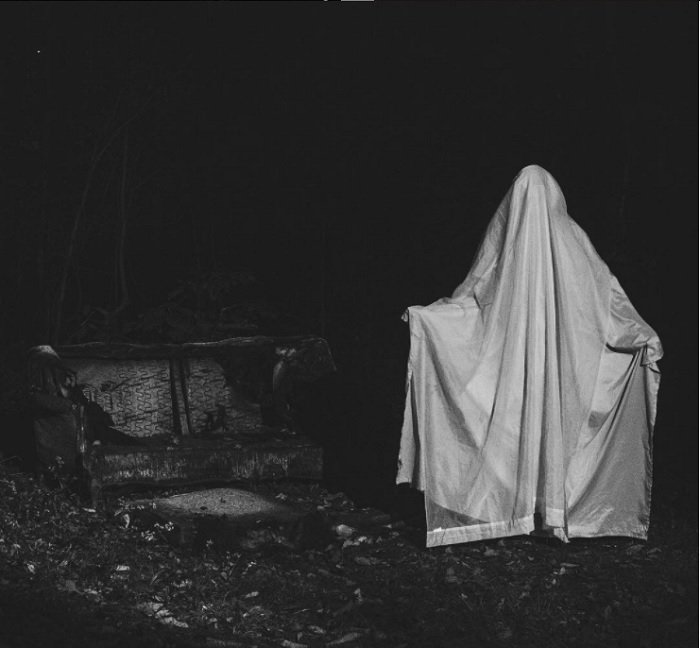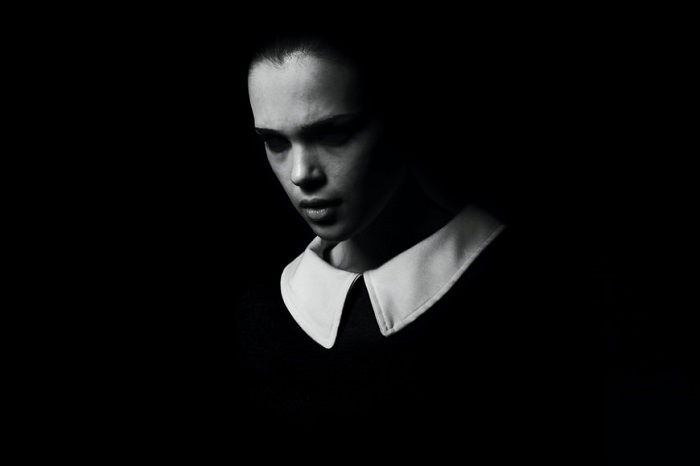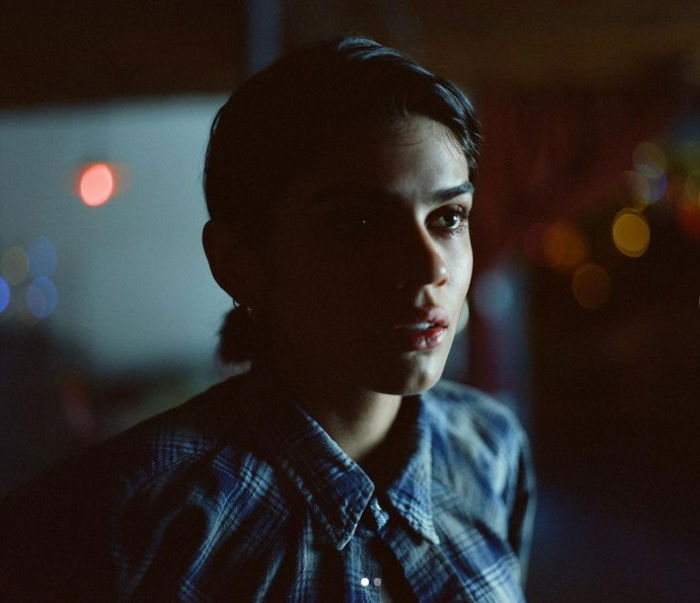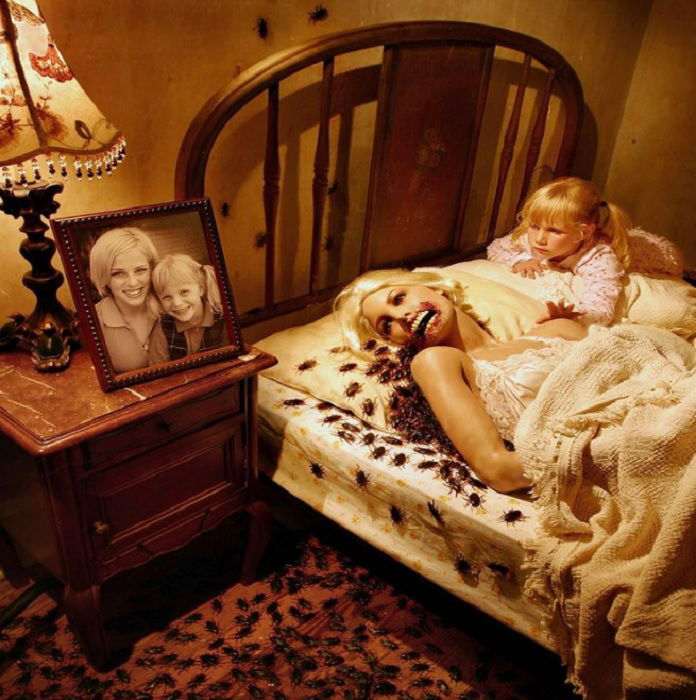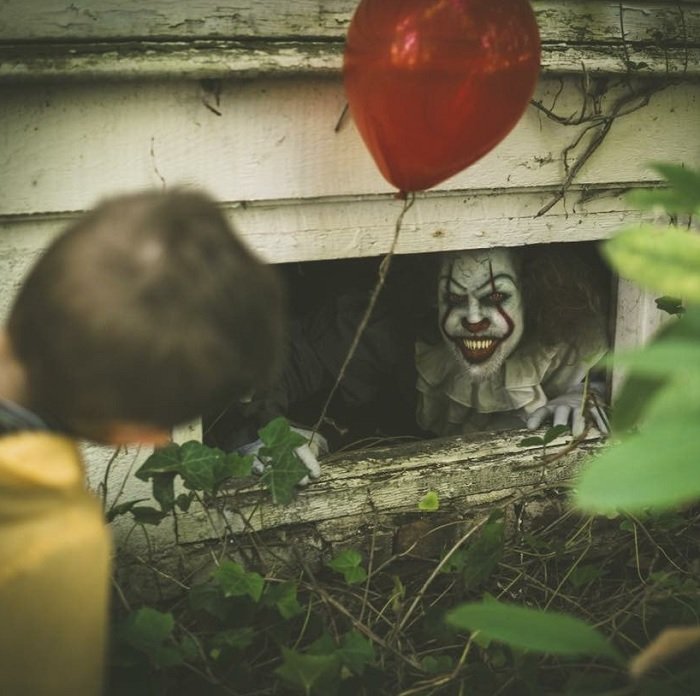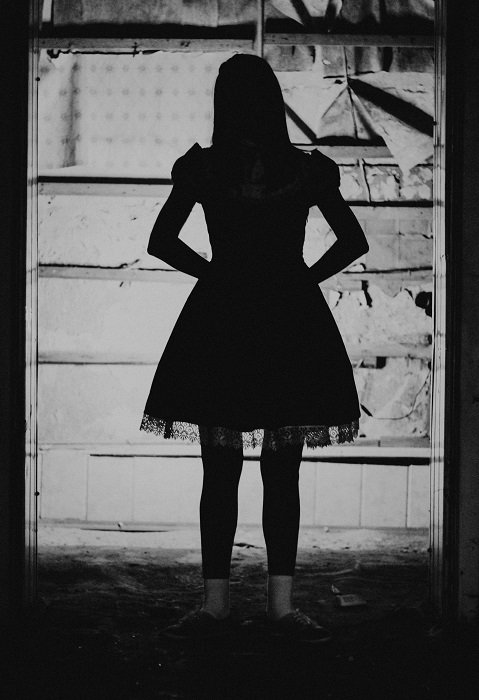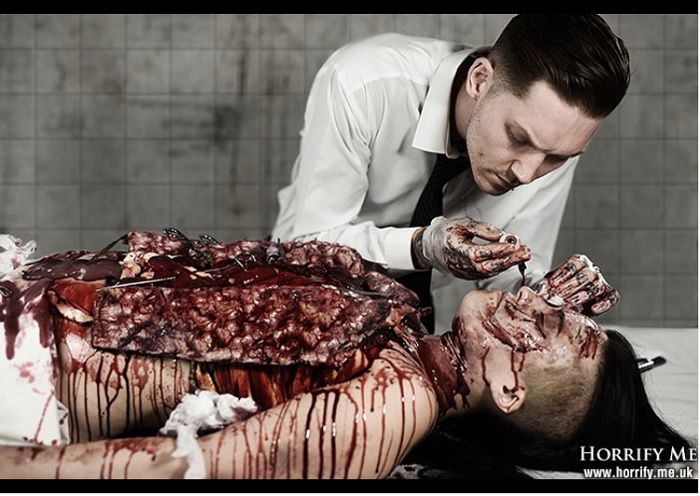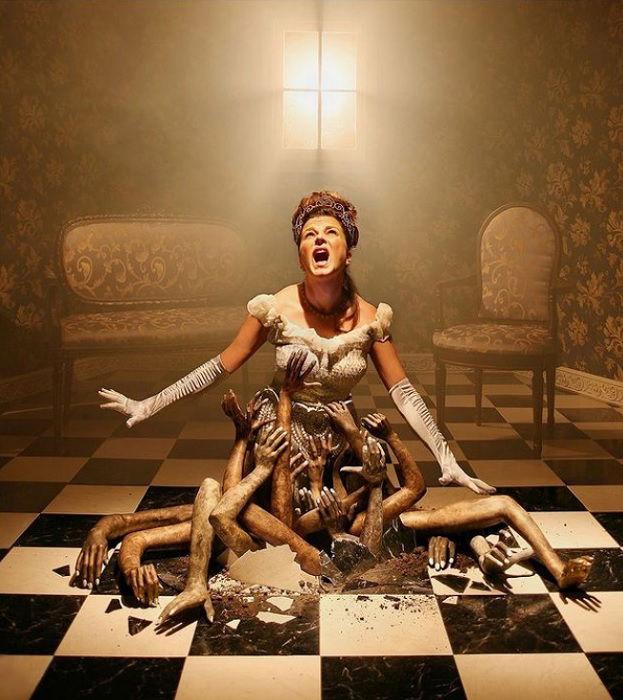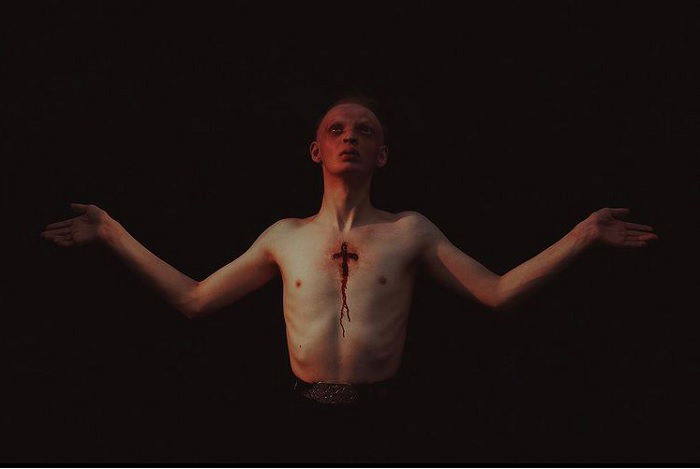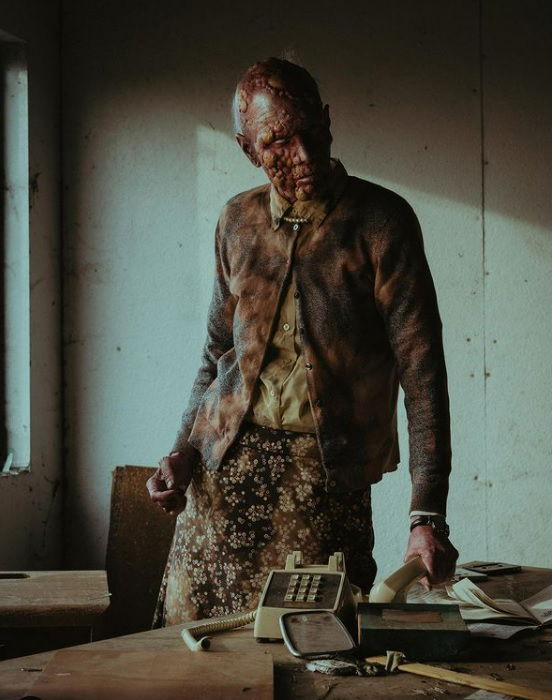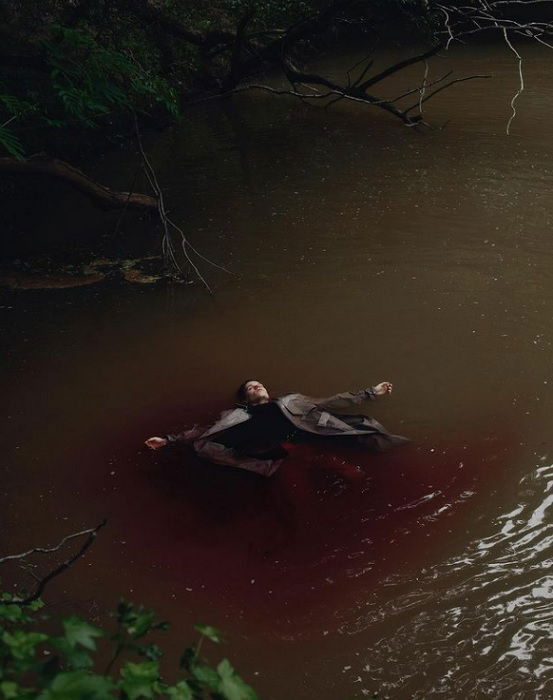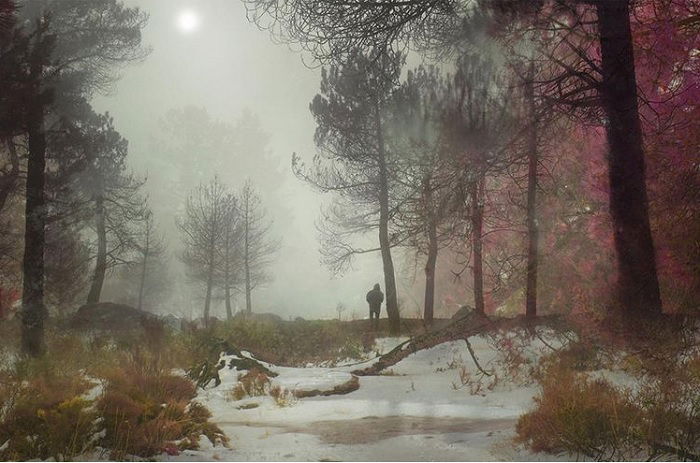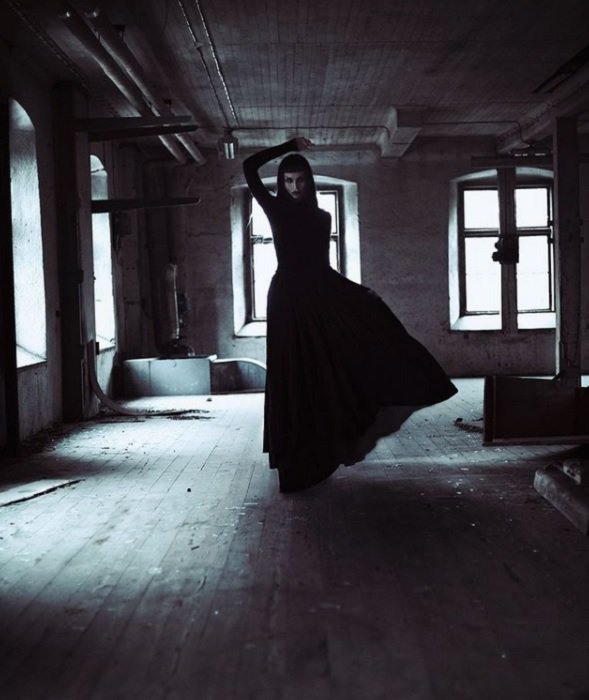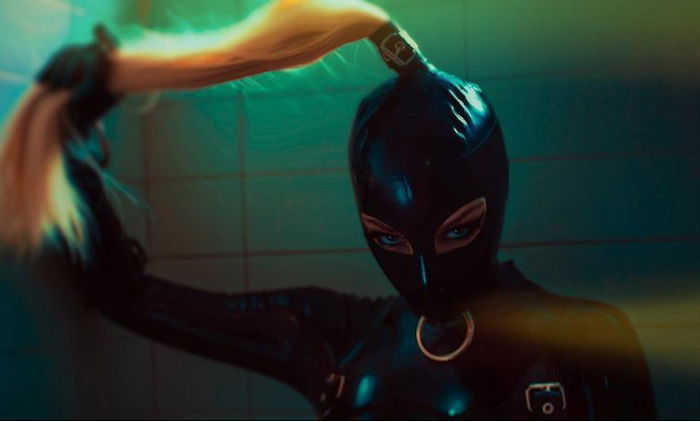But sometimes, we like to indulge our fears. We watch horror films, and we read scary stories. Horror can give us a thrill like no other. And horror photography is no different. In this article, we’ll give you some chilling examples of horror photography. Using the work of leading horror photographers, we’ll show you some of the themes they use to open the darkest corners of our imagination.
What is Horror Photography?
Horror photography is no different to horror cinema, except you’re using still images to tell your story. The aim is to excite the darker side of people’s imagination. You want to provoke the viewer and awaken their fears. The imagery can be explicit and violent. Or you could take a more subtle approach, creating tension and unease. Horror photography sometimes uses features of surreal and fantasy photography. Horror photographers are experts at employing storytelling techniques in their horror photographs. Horror photography isn’t just buckets of fake blood and fog machines. We have some excellent examples of how these artists use themes and tropes to frighten and horrify with their photography.
1. Out of the Darkness
Being afraid of the dark is one of our most primal and basic fears. Darkness deprives us of our most vital sense—sight. Without it, we feel vulnerable. We don’t know who, or what is out there. It’s one of the childhood fears that often stays with us. Maybe we don’t need to sleep with the light on anymore. But unknown noises from the dark can bring those feelings right back. Things don’t look the same at night. Familiar becomes unfamiliar. Friend becomes foe. Christopher McKenney is a horror photographer that has a passion for the eerie and evil. In his horror photograph below, we see a figure under a sheet. This is unnerving as we are unable to see who is beneath. But the real tension comes from the darkness that surrounds it. We can see some objects close to the subject, but very little beyond the figure. We can’t see where the subject has come from. Nor do we know what else hides within.
2. Hide The Windows to the Soul
Our eyes are an important part of being human. We use them to communicate. And we use eye contact to make connections with our fellow humans. That’s why removing them can have such a strong impact in horror photos. Removing or obscuring the eyes of a subject dehumanises them. We lose our ability to make that connection. They become distant and disconnected. Engin Akyurt demonstrates this in his portrait below. He obscures the eyes of his subject with shadow. And the eyes blend with the blackness that surrounds her. It creates an emotional distance that’s unnerving to the viewer.
3. Portray Fear in the Eyes
If we see a person looking at something, we have the urge to follow their gaze to see what they’re looking at. It’s one of the ways we can communicate with our eyes. And it’s a technique often used in horror photography. If the subject is looking at something out of shot, it can create a sense of unease. We want to see what they see, but we can’t. The edge of the frame stops us. All we have to lead us is the facial expression of the subject. If the face is full of fear, we feel it too. And it makes us want to see what else is there all the more. And the frustration that we can’t adds to the fear. Ryan Muirhead incorporates many horror storytelling techniques into his film photography. And the image below is a perfect example of how a photographer can direct our attention off-screen using eyes.
4. Exploit Frightening Phobias
Phobias are the things that, above all else, we just can’t stand. The very thought of them makes our skin crawl. There are many phobias common to the human race. Insects and spiders are feared and loathed by many, as are snakes and scorpions. That’s why these critters are often featured throughout the horror genre. Joshua Hoffine makes excellent use of these phobias in his work. The example below, ‘Bedside’, uses the unpopular cockroach. And, given that they’re my worst fear, I won’t be able to go into much detail.
5. Have Fun with Clowns
Clowns are another common phobia. They meant to be figures of fun and whimsy. But with the mask of makeup and an over-the-top outfit, it’s easy for the imagination to run wild. Clowns have now become a thing of fear rather than fun. Not only do they feature in horror movies, they are often the star. The scary clown has become one of the most popular Halloween outfits in modern times. Lance Reis loves the horror genre. And many of the recognisable monsters and murderers feature in his horror photographs. In his image below, he uses the clown from the film ‘IT’. The character is a perfect example of how, with just a few tweaks to the makeup and features, a clown becomes a monster.
6. The Innocence of Children
Children are a common feature in horror. Much of the time, they’re used to heighten the sense of danger. We can understand a child’s fears because we once had the same ones. But children can also be used as the source of fear. In horror, children become symbols of lost innocence and corrupted purity. This inverts our assumptions and their social norms. In the image below, Farida Davletshina uses the stark image of a child’s silhouette to bring about these emotions. We recognise the figure as a little girl because of her dress. But the setting and the fact we can’t see the face unbalances us.
7. Going Under The Knife
Good doctors are the pride of the community. But an evil one is our worst nightmare. They’re people we trust. They’re people we have to trust. And this relationship makes a bad doctor all the more horrifying. We are never more vulnerable than when we undergo an operation. When we go under the knife, we’re out cold. Anything could be done to us while we’re unconscious. Hospitals aren’t exactly pleasant places, but they have an air of respectability. But in desperate times, people are driven to backstreet doctors. They have medical skills, but can we trust them? This distrust is something Rick Jones captures so well. His images are gruesome and gory. But the real horror comes from our fear of being pried open while we’re completely helpless.
8. Take Their Breath Away—Suffocation
When it comes to how we want to leave this world and move on to the next, suffocating is pretty low on the list. Breathing is so natural to us. We do it without thinking about it. And that’s why the fear of losing the ability to breathe is so strong. When something so basic—something we take for granted—is denied, we panic. Kyle Thompson plays with our fear in much of his imagery. His photography isn’t as gory as others on this list. But his work is filled with tension and unsettling imagery. In the image below, he plays with the idea of suffocation. It could be a murder scene from a film. Or it could be a crime scene photograph. It makes us take a deep breath and be thankful we are still able to do so.
9. Hands of The Unknown
Most of the time, hands are fairly normal and non-threatening. We can look at our own without suffering a cold sweat. But in horror, hands can be used to frighten us. The fear comes when we can’t see to whom—or to what—the arm is attached. We fear what we don’t know and what we can’t see. And the hand is an able and dexterous part of the body. They can grab and they can grope. A hand can grasp, squeeze, and strangle. Joshua Hoffine provides us with the perfect example of this. He has a multitude of anonymous hands rising from the floor, grabbing and pulling the subject below. Are the hands disembodied? Who do they belong to? We can’t see. That’s why this technique is so powerful.
10. Religious or Blasphemous Imagery
Christianity isn’t all angels and Sunday songs. There’s also fire and brimstone in the pit of eternal damnation. And we can’t forget Satan himself. The darker aspects of Christianity have become themes throughout the horror genre. Nobody wants to go to hell. But we also fear what might rise from the underworld into our own. Being possessed is an example of losing control of oneself. Losing control to something dark and mysterious makes it even scarier. This is something we see in the photograph by Alex Stoddard. This piece is titled ‘Servant’. We are given some clues as to whom the subject is in the service of. There’s the blood-red face and the bleeding cross on his chest. The outstretched arms add another religious element.
11. Shine Light on Vampires
Vampires have been a staple in horror fiction for generations. From Bram Stoker’s ‘Dracula’ to ‘Buffy the Vampire Slayer’, they’re characters that capture our imagination. In modern media, vampires have become romantic figures. They play the mysterious and taboo love interest. But they can still bring fear to many. They’re the undead and they feast on blood. Jannike Viveka is an expert in gothic horror photography. Her photograph below depicts many themes we associate with vampires. There’s a contrast between horror and romance. The subject appears to be hunting… while wearing an elaborate white wedding dress—something we usually associate with purity.
12. Bring the Undead to Life
The zombie apocalypse is one of the most popular subgenres in horror. Whether it’s a post-nuclear fallout or the dead rising from the grave, the zombie is a horrifying prospect. The dead coming back to life is a perversion of our reality. Not only is a half-decomposed corpse disgusting, the soul of the person is no longer there. The zombie is a primitive being, human in form but stripped of all humanity. And they need to feast on the living. Lance Reis revels in the world of the undead. His costume and makeup design is exceptional, making a frightful nuclear winter a reality. Lance is a master of horror portraits.
13. Finding a Dead Body
In the horror genre, finding a dead body is more complicated than just seeing something we’d rather not. The questions surrounding the situation create tension just as much as the body. Who killed them? Why did they kill them? Will the killer strike again? The person who finds the body becomes part of the story. They are part of the crime. And will they be the next victim? The horror is amplified by the location of the body, which are often remote and isolated. The tension that arises from these questions is evident in the image below by Alex Stoddard. We have a murdered body in a woodland area. We have questions, but no answers.
14. Create an Eerie Scene in the Wilderness
No one wants to find ourselves stuck in the middle of nowhere. But sometimes that’s exactly where we end up. Being lost in a town or city is one thing. We can ask for directions and there are people (witnesses) around. But if you’re lost in the country, you’re on your own. Many horror films use rural locations for this very reason. Not knowing where we are puts us at a disadvantage. We are vulnerable and at the mercy of others. And we don’t know who those others will turn out to be. Henri Prestes is a landscape photographer with a strong cinematic style. His images are full of mystery and tension. We always feel like we’re venturing into the unknown when looking at his images. The photograph below is a perfect example.
15. Create a Haunted House
Old houses hold a lot of history. They’ve been host to a lot of things. And in some cases, those things are not always nice. The house could have been the scene of a death or a murder. Houses are our homes. They are meant to be the place we feel most comfortable and safe. But a spiritual presence removes our comfort. We no longer feel at home. We feel trapped. Our imaginations play with the idea that the house has absorbed bad omens. They infect the building itself. And those who reside there many years later will relive the unpleasantness of horrors past. The image below, by Jannike Viveka, depicts a haunting figure. She’s a scary subject. But the setting of an old house is just as important. Is this figure linked to the house? Or has she been created by the house?
16. Combine Horror and Sexual Fantasy
Over the decades, horror has become intertwined with sexual fantasy. We’ve seen the sexualisation of vampires in ‘Buffy The Vampire Slayer’ and the ‘Twilight’ series. Modern Halloween costumes are becoming less scary and more sexy. If you look at some of the costumes used in horror and BDSM, there’s a lot of overlap. There’s leather, straps, and other torture devices. And there’s the combination of pleasure and pain. Maybe I’m getting too Freudian, but a person’s kinks—like their fears—come from the deepest depths of their personality. And in a highly sexualised world, the two can be confused. While some people like to get undressed in the bedroom, others like to dress up. Ashley Von Helsing creates a world that is both sexual and horrific. She uses tropes from horror, boudoir, and sexual fantasy. It’s dark and it’s gothic. And it scares you in more ways than one.
Conclusion
Horror photography gives us a thrill. It plays with our fears. The images stick in our mind, whether we want them to or not. Horror can include elements of fantasy and surreal photography. These help to tell visual stories that ignite our imagination and arouse our darkest fears. There are many ways photographers scare us with their imagery. You can use elaborate props and realistic horror makeup. Or you can set eerie scenes that rely on tension. If you want to delve into horror photography, our Magical Photography Spellbook will instruct you on how to add character and mood to any photograph. And it will teach you how to create levitation in your photos! If you have a passion for the gruesome and the macabre, you can create horror photography yourself. Explore some of the themes demonstrated by photographers in this article to create your own horrifying imagery.
